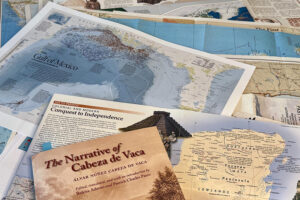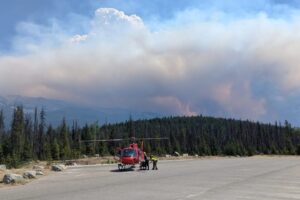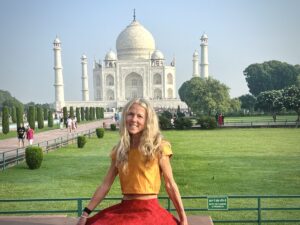I still vividly remember the time back in 1987 that Dad brought home a video camera. We thought that the heavy object (which was about the size of a sack of sawdust) was pretty futuristic. Its chunky, sharp edges sat on Dad’s shoulder as he wielded it in our faces. We recited books and showed off our toys for our audience — family members in another city.
Looking back on that 1987 footage, it’s evident how puzzled we were by the camera. At one point I naively ask, “Will I see myself, Dad?” as I attempt to understand the concept of watching later something which is occurring now.

Dan Clark and his family on their tundra adventure
In Together to the Tundra, though, Dan Clark’s family is clearly a lot more familiar with the idea of family films. And their days involve far greater adventures than those of ’87 in our backyard.
It’s 2015, and the scenery is “distinctly Canadian”, as Dan puts it. Skies are bright blue, waterways trickle in pristine light and shadow. This is clearly a part of nature that hasn’t yet been scathed by civilization.

A calm day in the tundra.
Dan and his family are exploring the tundra lakes of Canada’s Northwest Territories. If, like me, you are unclear exactly what tundra is, it’s “a vast, flat, treeless arctic region…in which the subsoil is permanently frozen.”
Though the tundra in this film doesn’t appear to be frozen, it’s certainly a vast, barren land with low foliage and arteries of interconnecting waterways. It’s a perfect location for schooling children on the natural world. Exploring here is best described as temporarily living in the tundra.
Canoes serve both as transport and as a means of carrying gear. Tents, sleeping bags, cooking pots and clothing all stow away in waterproof bags. Toward the stern, the two kids, Kobe and Ava Fei, sit comfortably side by side, with an adult paddling in the bow and a camera person/paddler in the stern. At times, the kids help paddle; other times, they chat with one another or do their math homework.

Kobe and Anna Fei crack the books during a big lake crossing.
Despite the beauty of the countryside, the landscape is not the real show stopper. Anna Fei and Kobe are. Perhaps no older than 10 (Kobe seems to be the elder), these two have bonded far more closely than many siblings. Could it be the result of learning outdoors, without modern distractions like Playstation or the Cartoon Network? In every scene with the children, they’re either hugging one another, playing games together or helping each other build something from natural resources. Call it exploring.
In one scene, Anna Fei spontaneously gives her brother a hug as the camera shoots from above. In another, they do homework in the canoe. They’re always giggling and laughing. This is what makes the film such a joy.

Kobe and Anna Fei’s bond shines through.
Paddling upstream on the Lockhart River, they damage their canoes. After more than 400km, freezing temperatures and constant rain in late summer further signal that the great adventure is over, for now. Dan’s stated goal for the trip is “to be lost in the freedom of a patchwork of waterways.” Yet what he’s achieved is so much more.

A portage between lakes.
In the natural wonderland of the tundra, captured in the lens of a family film that easily outdoes mine of 30 years ago, Dan has given his whole family the time and place to be happy with one another and with the world around them.






